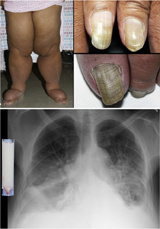
Lymphedema, also known as lymphoedema and lymphatic edema, is a condition of localized swelling caused by a compromised lymphatic system. The lymphatic system functions as a critical portion of the body's immune system and returns interstitial fluid to the bloodstream. Lymphedema is most frequently a complication of cancer treatment or parasitic infections, but it can also be seen in a number of genetic disorders. Though incurable and progressive, a number of treatments can improve symptoms. Tissues with lymphedema are at high risk of infection because the lymphatic system has been compromised.

Aagenaes syndrome is a syndrome characterised by congenital hypoplasia of lymph vessels, which causes lymphedema of the legs and recurrent cholestasis in infancy, and slow progress to hepatic cirrhosis and giant cell hepatitis with fibrosis of the portal tracts.

Telangiectasias, also known as spider veins, are small dilated blood vessels that can occur near the surface of the skin or mucous membranes, measuring between 0.5 and 1 millimeter in diameter. These dilated blood vessels can develop anywhere on the body but are commonly seen on the face around the nose, cheeks and chin. Dilated blood vessels can also develop on the legs, although when they occur on the legs, they often have underlying venous reflux or "hidden varicose veins". When found on the legs, they are found specifically on the upper thigh, below the knee joint and around the ankles.

Lipedema is a disorder where there is enlargement of both legs due to deposits of fat under the skin. Typically it gets worse over time, pain may be present, and sufferers bruise easily. In severe cases the trunk and upper body may be involved. Lipedema is commonly misdiagnosed.
Lymphangiosarcoma is a rare cancer which occurs in long-standing cases of primary or secondary lymphedema. It involves either the upper or lower lymphedematous extremities but is most common in upper extremities. Although its name implies lymphatic origin, it is believed to arise from endothelial cells and may be more accurately referred to as angiosarcoma.

Yellow nail syndrome, also known as "primary lymphedema associated with yellow nails and pleural effusion", is a very rare medical syndrome that includes pleural effusions, lymphedema and yellow dystrophic nails. Approximately 40% will also have bronchiectasis. It is also associated with chronic sinusitis and persistent coughing. It usually affects adults.
Stewart–Treves syndrome, refers to a lymphangiosarcoma, a rare complication that forms as a result of chronic, long-standing lymphedema. Although it most commonly refers to malignancies associated with chronic lymphedema resulting from mastectomy and/or radiotherapy for breast cancer, it may also describe lymphangiosarcomas that result from congenital and other causes of chronic secondary lymphedema. Lymphangiosarcoma arising from cancer-related lymphedema has become much less common with better surgical techniques, radiation therapy, and conservative treatment. The prognosis, even with wide surgical excision and subsequent radiotherapy, is poor.

Lymphedema–distichiasis syndrome is a medical condition associated with the FOXC2 gene. People with this hereditary condition have a double row of eyelashes, which is called distichiasis, and a risk of swollen limbs due to problems in the lymphatic system.

Kindler syndrome is a rare congenital disease of the skin caused by a mutation in the KIND1 gene.

Milroy's disease (MD) is a familial disease characterized by lymphedema, commonly in the legs, caused by congenital abnormalities in the lymphatic system. Disruption of the normal drainage of lymph leads to fluid accumulation and hypertrophy of soft tissues.
Persistent edema of rosacea is a hard, nonpitting edema found on the areas involved, those mainly being the forehead, glabella, upper eyelids, nose, and/or cheeks.
Keratitis–ichthyosis–deafness syndrome presents at birth/infancy and is characterized by progressive corneal opacification, either mild generalized hyperkeratosis or discrete erythematous plaques, and neurosensory deafness.
In racquet nails, the nail plate is flattened, the end of the thumb is widened and flattened, and the distal phalanx is abnormally short. In racquet nails, the width of the nail bed and nail plate is greater than their length. The condition is painless and asymptomatic.
Secondary lymphedema is a condition characterized by swelling of the soft tissues in which an excessive amount of lymph has accumulated, and is caused by certain malignant diseases such as Hodgkin's disease and Kaposi sarcoma.
Postinflammatory lymphedema is a condition characterized by swelling of the soft tissues in which an excessive amount of lymph has accumulated, and is caused by repeated bacterial infections.
Bullous lymphedema is a skin condition that usually occurs with poorly controlled edema related to heart failure and fluid overload, and compression results in healing.
Factitial lymphedema is a skin condition produced by wrapping an elastic bandage, cord, or shirt around an extremity, and/or holding the extremity in a dependent and immobile state.
Njølstad syndrome is a syndrome characterized by non-immune hydrops fetalis (NIHF), congenital pulmonary lymphangiectasia (CPL). Clinical features found in Njølstad syndrome include: facial and limbs lymphedema, facial abnormalities, pectus excavatum and vulvar and labial edema.
Hypotrichosis–lymphedema–telangiectasia syndrome is a congenital syndrome characterized by lymphedema, the presence of telegiectasias, and hypotrichosis or alopecia. Lymphedema usually develops in the lower extremities during puberty. Hair is normal at birth, but usually lost during infancy. Telangiectasias may present on the palms and soles more commonly than on the scalp, legs, and genitalia. The syndrome has been reported in association with both autosomal dominant and autosomal recessive inheritance patterns.







